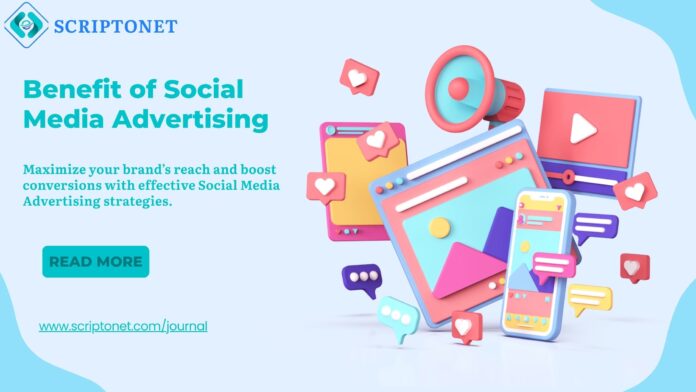Introduction
Social media advertising has emerged as a key component of marketing plans for companies of all kinds in the current digital landscape. The major benefit of social media advertising is that social media platforms have billions of active users, providing unmatched chances to engage with a wide range of people. Social media advertising gives companies the ability to market their goods, services or brands to customers directly in a method that is extremely engaging, targeted & economical.
The main benefit of social media advertising will be discussed in this article, with a focus on how it may greatly increase brand awareness & encourage consumer interaction. Social media gives a business the resources & adaptability it needs to improve visibility & interaction, whether it is trying to attract new clients or keep solid ties with current ones.
The practice of promoting goods, services or businesses via social media sites like Facebook, Instagram, Twitter, LinkedIn & TikTok is known as social media advertising. Through sponsored ads, it helps companies to engage with their target audience, build brand awareness & increase engagement. Businesses use social media, which has billions of users, to boost sales & cultivate client relationships.
Meaning of Social Media Advertising
The practice of leveraging social media platforms to provide paid promotional content to a particular audience is known as social media advertising. These advertisements can take many different forms, including sponsored posts, carousel ads, videos & photos. Effectively reaching potential clients & motivating them to take action, such as visiting a website, buying a product or interacting with the brand, is the aim.
Requirements of Social Media Advertising in Marketing
Businesses require the following to operate an effective social media advertising campaign:
- A well-defined strategy: A well-defined strategy includes campaign goals, target audience analysis & specific objectives.
- Relevant Social Media Platforms: Selecting platforms according to the audience’s demographics (example: Instagram for B2C, LinkedIn for B2B).
- Engaging Content: Informational & aesthetically pleasing advertisements designed for social media users.
- Budget Allocation: A projected expenditure for sponsored advertising that is determined by the size of the campaign.
- Ad Targeting Options: Ad targeting options include retargeting, location-based targeting & interest-based targeting.
- Analytics & Performance Tracking: Tracking ad performance with analytics & insights technologies to maximize outcomes.
Significance & Benefit of Social Media Advertising
- Massive Audience Reach: Social media is a potent marketing tool because it is used by billions of people.
- Cost-effective: Social media advertisements are less expensive than traditional forms of advertising.
- Brand Awareness & Recognition: Assists companies in creating & sustaining a powerful online presence.
- High Engagement & Customer Interaction: Facilitates direct engagement with potential customers.
- Targeted Marketing: Enables accurate targeting based on demographics, interests & behaviors.
- Increased Website Traffic & Conversions: This promotes purchases & brings customers to company websites.
- Competitive Advantage: Maintains a company’s lead in the field of digital marketing.
- Measurable Results: Offers information on ad performance to assist companies in improving their tactics.
Characteristics of Social Media Advertising
- Paid Promotions: This refers to a planned strategy for sponsored content advertising.
- Advanced targeting: Depending on demographics such as region, interests, age, and gender, advertisements can be customized to target certain groups.
- Multiple ad formats: Different types of formats are supported, including text-based advertising, carousels, tales, videos & photos.
- Instant Engagement: Clicks, likes, shares & comments allow users to engage with advertisements.
- Real-time analytics: Ad performance & audience behavior are revealed via real-time analytics.
- Retargeting capabilities: Companies can reach out to prospective clients who have already interacted with their advertisements.
- Mobile Friendly: Made with mobile users in mind, these ads are certain to show up on a variety of devices.
Benefit of Social Media Advertising in Marketing
- Greater Brand Visibility: Boosts internet presence & brand recognition.
- Targeted reach: Businesses can reach particular audiences by using targeted reach, which is based on demographics & interests.
- Economical: Provides a greater Return on Investment (RoI) than traditional advertising.
- Enhanced Engagement: Facilitates face-to-face communication with prospective clients.
- Improved customer insights: Social media analytics provide valuable insights into the behavior of customers.
- Increased Sales & Website Traffic: Promotes leads & conversions.
- Potential for Viral Marketing: Interesting information can spread extensively, expanding its audience.
Drawbacks of Social Media Advertising in Marketing
- Ad Fatigue: Viewers may become disinterested after too many commercials.
- High Competition: As more companies vie for users’ attention, ad expenses rise.
- Negative Feedback & Public Scrutiny: Brands are subject to unfavorable remarks & criticism.
- Algorithm Updates: Ad reach is impacted by the regular algorithm updates made by social media networks.
- Privacy Concerns: Ad targeting may be impacted by policy changes & data privacy concerns.
- Demands Constant Monitoring: To ensure that campaigns are effective, advertisers must constantly optimize them.
Social Media Advertising’s Use of Influencer Marketing
One of the most important developments in social media advertising is influencer marketing. It entails collaborating with people who have a sizable fan base on social media sites like YouTube, Instagram & TikTok in order to market goods & services.
Aspects of Influencer Marketing in Social Media Ads
- Influencer Collaborations: Companies work with influencers that have earned the confidence of their fan base. These influencers can use their established authority to help market a product or service in an authentic way. The collaboration may take the form of freebies, product placements, sponsored posts or even long-term partnerships.
- Comparison between Micro-Influencers & Celebrities:
- Micro-Influencers: Although their audiences are modest, these influencers have very active followers. They typically have more specialized fan bases & are seen as more trustworthy & relatable. Businesses that collaborate with micro-influencers frequently see reduced costs & increased engagement rates.
- Celebrity Influencers: Although they have sizable fan bases, celebrity influencers might not be as engaged or trusted as micro-influencers. They can, however, greatly increase brand awareness & reach a large audience.
- Trust & Credibility: Influencers are more credible in their suggestions since they have established relationships with their audience. Influencers are more inclined to take action when they recommend a brand since their followers trust their opinion.
- Measuring ROI in Influencer Campaigns: Determining a campaign’s efficacy is one of the difficulties in influencer marketing. Metrics including audience sentiment (the brand’s post-campaign perception), conversion rates (influencer-driven purchases), reach (the number of people who viewed the post), and engagement (likes, comments, shares) are crucial for evaluating performance.
- Content Development: Influencers produce genuine content that appeals to their followers. This raises the possibility of engagement by giving brands access to innovative, approachable content that complements the tone of the platform.
- Challenges with Influencer Marketing: Issues with authenticity, tracking results & influencer fit are some of the difficulties associated with influencer marketing.
Conclusion
Advertising on social media has completely changed how companies promote their goods & services. It provides an entertaining, highly targeted & affordable means of reaching new consumers & increasing brand recognition. Platforms like Facebook, Instagram, LinkedIn & TikTok have billions of active users, allowing marketers to access a wider audience, improve consumer interaction & increase conversion rates.
Businesses may optimize their Return on Investment (ROI) & build enduring client relationships by utilizing interactive content, real-time performance tracking & sophisticated targeting choices. To get the best results, social media advertising, like any marketing campaign, needs to be carefully planned, optimized & creatively executed. In today’s fast-paced, digital-first industry, companies that integrate social media advertising into their digital marketing plan will ultimately have a competitive advantage.
Key Takeaways
- Authenticity is crucial: Audiences respond more favorably to campaigns that are open & consistent with the brand’s principles.
- Engagement Produces Outcomes: It’s critical to have a two-way dialogue with your audience by answering comments or providing interactive material.
- Know Your Audience: Effective marketing strategies are adapted to the target audience’s requirements & inclinations.
- Make Use of User-Generated Content: One effective way to increase social proof is to motivate your audience to create content that supports your brand.
- Creativity & Simplicity: The most effective campaigns are frequently those that are straightforward, imaginative & have a clear call to action.
Frequently Asked Questions (FAQ)
Why is social media advertising important for businesses?
Businesses may reach a wider audience, increase brand awareness, interact with potential clients & boost sales in a quantifiable & economical manner with the use of social media advertising.
Can small businesses benefit from social media advertising?
Of course! Social media advertisements are a powerful tool for increasing sales & brand exposure since small firms can target particular demographics with a minimal expenditure.
What is the ideal frequency of social media ad posting?
The goals of the business determine the frequency. While some firms employ campaign-based or seasonal tactics, others broadcast advertisements continuously. The best course of action is determined with the help of A/B testing and performance monitoring.
Can a person advertise on social media without having a website for my business?
Indeed! Without requiring a website, several platforms let companies place advertisements that send customers to social network accounts, online marketplaces or lead generation forms.
How long does it take for social media advertisements to show results?
Ad quality, audience targeting & budget are some of the variables that can affect the results. While conversions may take a few days to weeks, some businesses notice engagement within hours. For long-term success, constant optimization is essential.


